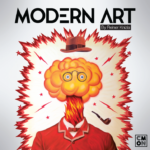Modern Art

Overview

- 10+
- 45 mins
- Strategy
- 3-5 Players
- Reiner Knizia
Modern Art is a 3-5 player game where players buy and sell paintings of famous painters via unique auction styles for maximum gains.
Game Setup:
It comes with game board, 70 cards with works from 5 different artists, and a screen for each player to hide money. Each player begins with $100, the cards are shuffled and dealt to each player according to the player count.
Count – 10 in a 3-player game, 9 in a 4-player game, and 8 each in a 5-player game and the remaining cards are left face down for future rounds.
Game Overview
The game consists of four rounds. Cards are auctioned off in each round, the number of paintings sold in each round determines the value of each artist at the end of the round.
The works of the artist who has sold most paintings in that round receives 30 points, second place receives 20 points, and third place receives ten points. The other two don’t score.
At the end of the round, players are paid based on the artist’s value for paintings they purchased in that round. The cards used in that round are returned to the box at the end of each round and they play no further part in the game.
The winner is the person with most money including after selling in the auctions, as well as the value of cards purchased in auction rounds, plus any cash in hand at the end of the game.
Auction Variations
Modern Art has four types of auctions: open, closed, one-time, and fixed-price. The game’s theme and mechanic are firmly established as auctions. The game emphasizes player interaction, and the learning curve is in understanding each auction type and determining the best value in each auction.
Players can pick and choose which types of auctions are best for them in order to achieve the best results, but they should not disregard the others. As you can see from our previous blogs (see For Sale), we enjoy auction games, and this game is the gold standard in auction games! The majority of games have one or two types of auctions. For example, in the game For Sale, there are two types of auctions: one where bidders increase until only one person remains during the buy phase, and one where bidders decrease until only one person remains during the buy phase. and a closed bid, in which different properties are placed in secret by players at the same time in order to receive the checks in the sell phase.
Game balance and luck element
Before we get into the auction types, we wanted to discuss the balance and mechanics. What I like best about auction mechanics is that it is frequently self-balancing, and the state of the game is determined by the player. There is very little luck involved, except for card draw, apart from that, the game in auctions changes based on the tenders. This results in varying ebbs and flows in each game.
Auction Types
The auction type will be indicated by symbols on each art card.
Open/free auction: In the case of an open auction, the auctioneer places the card in the center of the table and there is no bidding order like a normal auction. Any player can place a bid at any time. The person who offers to pay the highest buys the painting.
Once around the auction: When this type of painting is auctioned, beginning from the player to the left of the auctioneer each player gets to bid once and only once either the player has to bid or pass. The following bids must be higher than the previous bid. the winning bid the auctioneer has two options: either sell to the highest bidder or buy the painting themselves by paying the highest bid amount to the bank.
Closed/Secret Auction: When this type of painting is auctioned, each player secretly bids the amount they are willing to pay in a closed fist. Once everyone has made their decision, everyone simultaneously reveals and the player with the highest bid wins. In the event of a tie, the player closest to the the auctioneer is the victor.
Fixed Price Auction: When this card is played, the auctioneer determines a fixed price for the painting, and each player, beginning from the left of the auctioneer is presented with a chance to buy. They can either buy or decline. If all bidders decline, the auctioneer must purchase at the set price.
Double Auction: In this scenario, it allows the auctioneer to sell 2 paintings at the same time. The second painting will determine the the type of auction that will be followed, and the price set is for both the paintings.
A double auction can drastically alter the state of the game and allow players to catch up. Players must reassess their situation to ensure they finish the round in time favorable situation.
The double auction card can also be used in conjunction with another player if they play another card by the same artist However, the original auctioneer is at a risk, because the auction proceeds goes to the player who adds the second card.
Playing the painting with the right type of auction, stacking of double auctions, as well as their timing, is what keeps the experienced players on their toes.
Simple Rules
Modern Art, as an auction game, is all about buying and selling by means of auctions. It is simple to teach and play and takes about 10-15 minutes. Modern Art is also distinguished by the fact that it was created in the twentieth century. After phases, the leader board provides a sense of price discovery. This is beneficial. Beginners have a frame of reference and do not feel oblivious to the situation. Approximations of the painting’s and artists’ values Of course, there is the actual The auction can sell for much less or much more than the stated value. The game’s enjoyable aspect!
Conclusion
Modern art is a game with a short learning curve; to learn how to play. It is necessary to understand and teach the various types of auctions; it is enjoyable. It has elements of player interaction and is simple to play. This is one of our favorite go-to auction games; it’s quick to play and easy to teach to newbies.